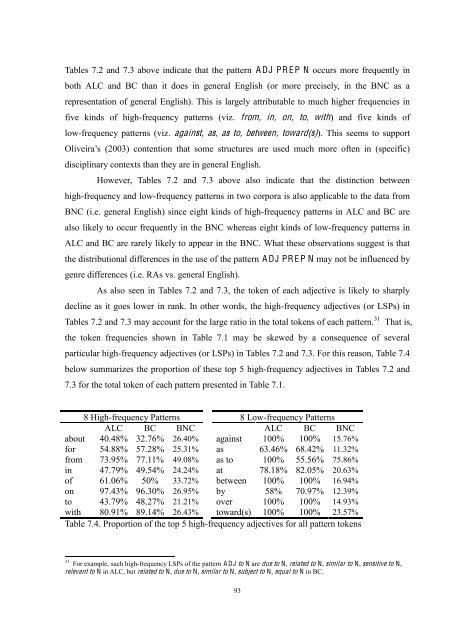Evaluative Meanings and Disciplinary Values - eTheses Repository ...
Evaluative Meanings and Disciplinary Values - eTheses Repository ...
Evaluative Meanings and Disciplinary Values - eTheses Repository ...
Create successful ePaper yourself
Turn your PDF publications into a flip-book with our unique Google optimized e-Paper software.
Tables 7.2 <strong>and</strong> 7.3 above indicate that the pattern A DJ PR EP N occurs more frequently in<br />
both ALC <strong>and</strong> BC than it does in general English (or more precisely, in the BNC as a<br />
representation of general English). This is largely attributable to much higher frequencies in<br />
five kinds of high-frequency patterns (viz. from, in, on, to, with) <strong>and</strong> five kinds of<br />
low-frequency patterns (viz. against, as, as to, between, toward(s)). This seems to support<br />
Oliveira (2003) contention that some structures are used much more often in (specific)<br />
disciplinary contexts than they are in general English.<br />
However, Tables 7.2 <strong>and</strong> 7.3 above also indicate that the distinction between<br />
high-frequency <strong>and</strong> low-frequency patterns in two corpora is also applicable to the data from<br />
BNC (i.e. general English) since eight kinds of high-frequency patterns in ALC <strong>and</strong> BC are<br />
also likely to occur frequently in the BNC whereas eight kinds of low-frequency patterns in<br />
ALC <strong>and</strong> BC are rarely likely to appear in the BNC. What these observations suggest is that<br />
the distributional differences in the use of the pattern A DJ PR EP N may not be influenced by<br />
genre differences (i.e. RAs vs. general English).<br />
As also seen in Tables 7.2 <strong>and</strong> 7.3, the token of each adjective is likely to sharply<br />
decline as it goes lower in rank. In other words, the high-frequency adjectives (or LSPs) in<br />
Tables 7.2 <strong>and</strong> 7.3 may account for the large ratio in the total tokens of each pattern. 31 That is,<br />
the token frequencies shown in Table 7.1 may be skewed by a consequence of several<br />
particular high-frequency adjectives (or LSPs) in Tables 7.2 <strong>and</strong> 7.3. For this reason, Table 7.4<br />
below summarizes the proportion of these top 5 high-frequency adjectives in Tables 7.2 <strong>and</strong><br />
7.3 for the total token of each pattern presented in Table 7.1.<br />
8 High-frequency Patterns 8 Low-frequency Patterns<br />
ALC BC BNC ALC BC BNC<br />
about 40.48% 32.76% 26.40% against 100% 100% 15.76%<br />
for 54.88% 57.28% 25.31% as 63.46% 68.42% 11.32%<br />
from 73.95% 77.11% 49.08% as to 100% 55.56% 75.86%<br />
in 47.79% 49.54% 24.24% at 78.18% 82.05% 20.63%<br />
of 61.06% 50% 33.72% between 100% 100% 16.94%<br />
on 97.43% 96.30% 26.95% by 58% 70.97% 12.39%<br />
to 43.79% 48.27% 21.21% over 100% 100% 14.93%<br />
with 80.91% 89.14% 26.43% toward(s) 100% 100% 23.57%<br />
Table 7.4. Proportion of the top 5 high-frequency adjectives for all pattern tokens<br />
31 For example, such high-frequency LSPs of the pattern A DJ to N are due to N, related to N, similar to N, sensitive to N,<br />
relevant to N in ALC, but related to N, due to N, similar to N, subject to N, equal to N in BC.<br />
93
















